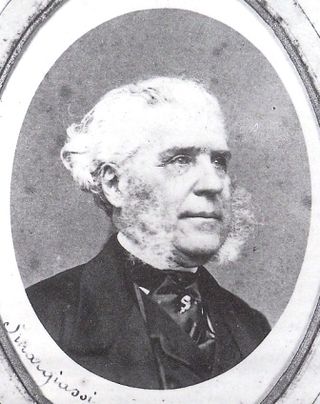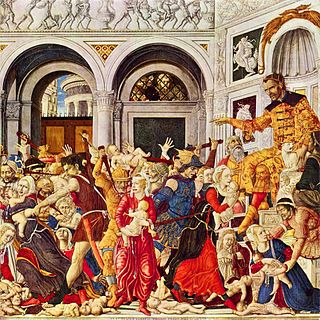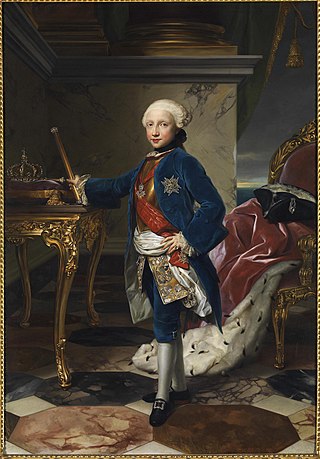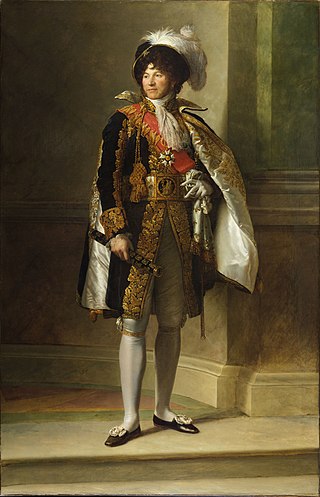
The following is a timeline of the history of the city of Naples. The Naples area has been inhabited since the Neolithic period. The earliest historical sources in the area were left by the Myceneans in the 2nd millennium BC. During its long history, Naples has been captured, destroyed and attacked many times. The city has seen earthquakes, volcanic eruptions, foreign invasions and revolutions.

Gabriele Smargiassi was an Italian landscape painter and professor at the Academy of Fine Arts in Naples.

Sacrificial Scene is a grisaille tempera on canvas painting by Pontormo, produced around 1520 and now in the National Museum of Capodimonte in Naples. It was probably originally produced as part of the decoration of an interior in honour of Cosimo de' Medici.

Massacre of the Innocents is a tempera on panel painting by Matteo di Giovanni, produced between 1450 and 1500 possibly in 1468, 1478, or 1488) probably in Siena. It was commissioned by Alfonso II of Naples, then living in Siena as part of the campaign against the Medici. It was probably produced to commemorate the inhabitants of Otranto killed by the Ottomans in 1480 whose relics were moved into the church of Santa Caterina at Formiello at Alfonso's request - the same church also originally housed the painting. It is now in the National Museum of Capodimonte.

Charles III's Departure for Spain, Seen from the Sea is a 1759 oil on canvas painting by Antonio Joli, showing Charles leaving Naples to be crowned king of Spain after the death of his two elder brothers. It and its pair Charles III's Departure for Spain, Seen from the Land are now in the National Museum of Capodimonte in Naples.

Last Judgement is a 1549 tempera on panel painting by Marcello Venusti after Michelangelo's Sistine Chapel The Last Judgement (1541). It is now in the National Museum of Capodimonte in Naples.

Assumption of the Virgin with Saint John the Baptist and Saint Catherine of Alexandria is an oil-on-panel painting by the Italian Renaissance painter Fra Bartolomeo, created c. 1516, commissioned by the church of Santa Maria in Castello in Prato. To the left of the Virgin's tomb is John the Baptist, whilst to the right is Catherine of Alexandria. It is now in the National Museum of Capodimonte in Naples.

Allegory of Justice is an oil-on-panel painting by the Italian Renaissance artist Giorgio Vasari. The painting was commissioned on 6 January 1543 by cardinal Alessandro Farnese for the main room of the Palazzo della Cancelleria in Rome, and was executed the same year. It and the rest of the Farnese collection were later moved to Naples and it is now in the National Museum of Capodimonte.

Charles of Bourbon Visiting Pope Benedict XIV at the Coffee House del Quirinale is an oil-on-canvas painting by the Italian painter Giovanni Paolo Pannini, commissioned by Charles of Bourbon in 1746 and completed the same year. It depicts Charles' visit to Rome after the Bourbon victory over the Austrians at the Battle of Velletri in 1744 – he and pope Benedict XIV were already friends and had signed a Concordat in 1741.

Charles of Bourbon Visiting St Peter's Basilica is an oil-on-canvas painting by Italian artist Giovanni Paolo Pannini, commissioned by its subject Charles of Bourbon in 1746 and completed later that year. It was part of the commission as the same artist's Charles of Bourbon Visiting Pope Benedict XIV at the Coffee House del Quirinale and both works are now in the National Museum of Capodimonte in Naples.

Ferdinand I and His Family is a 1782 oil-on-canvas painting by the Swiss artist Angelica Kauffman, now in the National Museum of Capodimonte in Naples.

Portrait of Maria Luisa of Parma is a portrait of Maria Luisa of Parma, wife of Charles IV of Spain, produced as a pendant painting to a portrait of her husband. Both works were long thought to be a copy after an autograph work by Francisco Goya, but they have now been definitively reattributed as autograph works by Goya himself, produced late in the 18th century. Goya was a court artist to the royal family, though most of his paintings of them are still in the Prado Museum. The two works were commissioned by the couple's daughter Maria Isabella of Spain. They were sent to Maria Isabella and they are both now in the National Museum of Capodimonte in Naples.

Portrait of Ferdinand IV is an 1759 painting by Anton Raphael Mengs, now in the National Museum of Capodimonte, in Naples.

Portrait of Philip II is an oil on canvas portrait by Titian of Philip II of Spain wearing the chain of the Order of the Golden Fleece. It is in the collection of the Museo di Capodimonte, in Naples.

Portrait of Joachim Murat is an oil-on-canvas painting created in 1808 by the French painter François Gérard. It depicts general Joachim Murat. It is held in Room 54 of the National Museum of Capodimonte, in Naples.

Penitent Magdalene is a c. 1550 oil on canvas painting by Titian, now in the Museo di Capodimonte in Naples.

Portrait of Cardinal Alessandro Farnese is a c. 1545 – 46 oil on canvas three-quarter-length portrait of Alessandro Farnese the Younger (1520–1589) by Titian, now in the Museo nazionale di Capodimonte in Naples.

Portrait of Pope Paul III with Camauro is a 1545 – 1546 oil on canvas painting by Titian, now in the Museo nazionale di Capodimonte in Naples.

The Earthly Trinity with Saints and God the Father are a pair of c.1626-c.1635 oil on canvas paintings by Jusepe de Ribera, both now in the Museo nazionale di Capodimonte in Naples. Along with the Holy Family, the main work shows Bruno of Cologne, Benedict of Nursia, Bernardino of Siena and Bonaventure.

Saint John the Baptist is a c.1653-1656 oil on canvas painting by Mattia Preti, now in the Museo nazionale di Capodimonte in Naples.




















